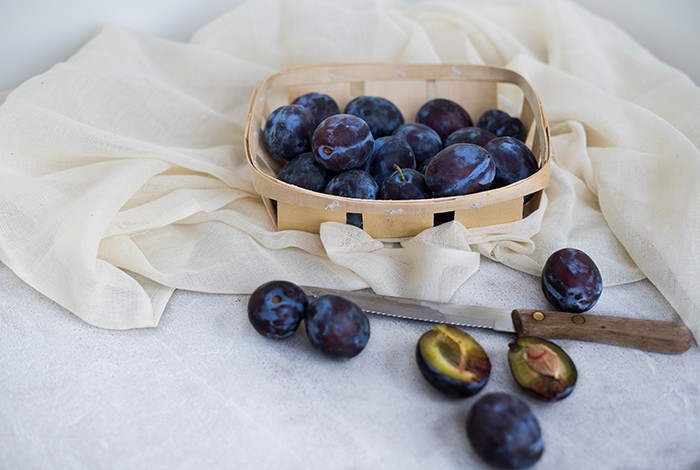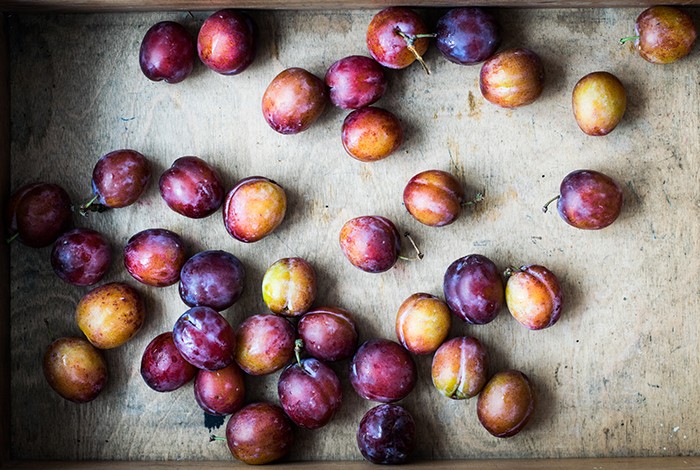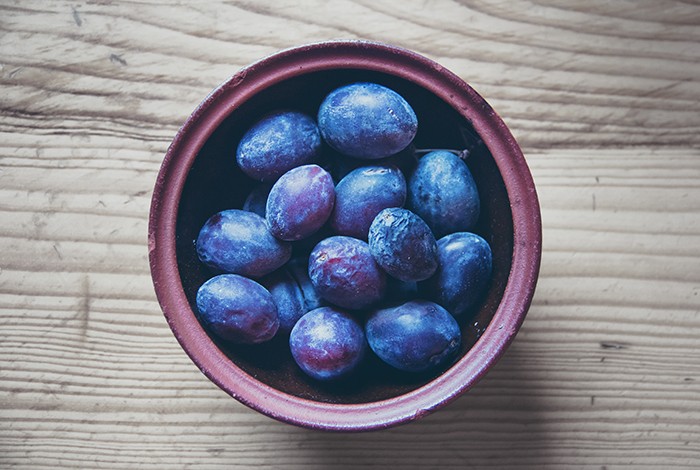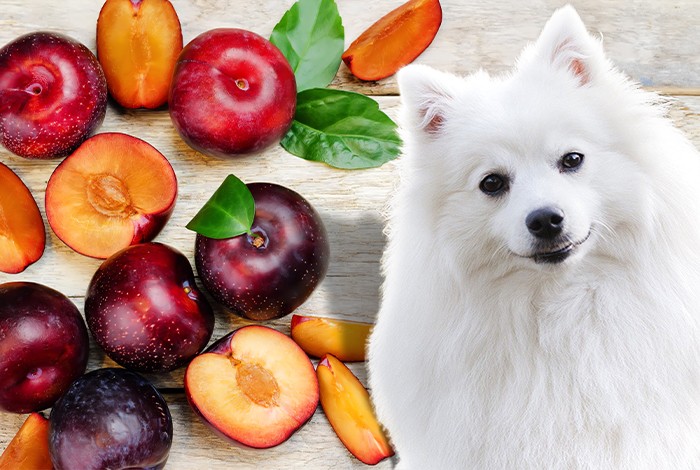![]() Reviewed By Joana Garrido DVM
Reviewed By Joana Garrido DVM
Can dogs eat plums? The answer is both yes and no. While plums can provide numerous health benefits for dogs, it’s important to be aware of the potential risks associated with this fruit.
In this article, we’ll discuss both the benefits and potential dangers of feeding plums to your dog. By following some simple guidelines, you can safely share this tasty fruit with your pup.
5 Health Benefits of Plums for Dogs
Are plums good for dogs? Yes, they are. If you’re wondering what makes plums great treats for dogs, here are the five health perks pooches can reap from these juicy fruits.
- Plums promote good digestion.
Plums are full of soluble and insoluble fiber. These are essential to your dog’s digestive system as they support good gut health. Moreover, they aid in preventing various digestive problems and diseases. These include constipation and colon cancer. - Plums lower cholesterol.
Soluble fiber not only promotes a well-functioning gastrointestinal tract, but it is also helpful in reducing the creation of enzymatic acids. These acids are involved in cholesterol production in the liver, thereby lowering cholesterol levels. - Plums support proper bone growth.
Plums contain calcium, which is vital in improving your dog’s bone growth and development. It also prevents bone problems in canines, such as arthritis. Calcium also plays a big role in keeping teeth and gum diseases at bay. - Plums aid in weight loss.
The fiber in plums helps normalize blood sugar levels. It is done by slowing down the absorption of glucose in your dog’s body. Since plums are rich in fiber, they give your dog a feeling of fullness, leading him to consume lesser food. - Plums strengthen the immune system.
Plums are an excellent source of vitamin C, which is an antioxidant that encourages lymphocyte production in the blood. Lymphocytes are white blood cells that are responsible for immune system function. Vitamin C is also vital in protecting your dog from various diseases such as heart disease, diabetes, and osteoarthritis.
4 Risks of Feeding Plums to Dogs
 Unlike cats, dogs can taste sweetness just like us. There’s no wonder Fido loves munching on a ripe plum. Its sweet taste is enough to excite his taste buds.
Unlike cats, dogs can taste sweetness just like us. There’s no wonder Fido loves munching on a ripe plum. Its sweet taste is enough to excite his taste buds.
Although plums can be a delicious and nutritious snack for dogs, it’s important for dog owners to be aware of the potential health risks associated with serving them improperly. Here are some of the most common issues to watch out for when feeding your pup this tasty fruit:
1. Full of Sugar
Plum is considered a low-calorie treat for dogs. However, this advantage will be undermined if you excessively feed it to your pooch. That’s because plum is packed with sugar, especially the ripe ones.
Allowing your dog to eat too much plum can lead to weight gain. It can also cause other long-term effects, such as tooth decay and diabetes.
While reading this, you may be asking yourself: “Can dogs have dried plums then? What about canned plums?”
Dogs can eat dried plums and canned plums, but it is not recommended. Dried and canned plums contain higher concentrations of sugar which can cause gastrointestinal upsets due to their poor digestibility. Therefore, they are not suitable as dog treats for your pooch.
2. Choking Hazard
Can dogs eat plums? Yes, so long as the plum pits are removed. Plum pits have a hard exterior, which is difficult to chew.
If your dog accidentally swallows it, he is at risk of choking. The sharp-pointed ends of the pits can scratch and damage his mouth, esophagus, and stomach. Without medical care, this situation can become life-threatening to your dog.
3. Intestinal Obstruction
The hard plum pit is extremely indigestible. Even if your dog manages to swallow it without choking, he is still at risk of impaction. This means it becomes lodged in his digestive tract, blocking the transportation of waste.
As a result, it causes waste buildup and can lead to your dog being hospitalized or requiring surgery due to symptoms such as stomach pain, vomiting, dehydration, and bloat. Intestinal blockage requires immediate medical attention, or else it can lead to fatal consequences.
4. May Cause Plum Poisoning

While the answer to “Can dogs eat plums?” is yes, know that this fruit is not entirely free from toxins.
Although the plum’s flesh is free from toxic substances, its pit contains cyanide, which is toxic to dogs. If the pit is crushed, the chemical will be released and may cause plum poisoning.
This condition will disrupt the transportation of oxygen to the blood cells. Lack of appropriate treatment can result in blood cell damage, respiratory collapse, and death.
Can dogs eat plums’ roots, leaves, and stems?
No, dog owners must know that the fruit’s leaves, roots, and stems all contain cyanide, which can cause plum poisoning. So if you have a plum tree in your garden, it should be fenced to keep your dog away from it.
Be sure to pick up fallen plums and supervise your dog when he is frolicking in the garden too.
Some may wonder if the effects of plum poisoning are the same as grapes and raisins. No, as each of them has a different side effect on dogs.
Grapes and raisins cause stomach upset and kidney failure if ingested, even in small amounts.
Meanwhile, large amounts of the fruit’s pits need to be ingested to induce plum poisoning.
What Should You Do If Your Dog Eats a Plum?
If your dog eats plum flesh, in most cases, you do not need to do anything since this part of the fruit does not contain toxins.
On the other hand, ingesting the pit or other parts of the plum tree, such as the flower, stem, roots, or pit of the fruit, calls for close monitoring. These specific plant parts contain toxins such as hydrogen cyanide, prunasin, amygdalin, and cyanogen. Your dog might begin to show symptoms of plum poisoning such as:
- Difficulty breathing
- Dilated pupils
- Agitation
- Redness of mouth, gums, and tongue
- Heavy panting
- Convulsions
- Seizures
- Collapse
If your dog shows any of these clinical signs, take him to the vet immediately. Diagnosing plum poisoning will require your dog to undergo several laboratory tests.
These include blood urea nitrogen, packed cell volume, and complete blood count.
Treatment for plum poisoning involves detoxification. This will be done by administering medication into your dog’s intravenous fluids.
Once the plum poisoning is under control, the vet will closely monitor him for around 24 hours. They will check his fluids, oxygen, and other aftercare needed for your dog’s quick recovery.
How to Safely Feed Plums to Your Dog

- Choose organic plums
Organic plums have low exposure to chemicals. Always wash the fruits thoroughly when preparing them for your dog. - Remove the pit when preparing the fruit.
Make it a habit to remove the pit when preparing the fruit. Doing so will make the fruit safe for dogs to eat. - Be sure to cut up the pitted fruit into small pieces.
Never feed whole plums to your dog, or he may end up choking. You can also turn it into a puree and spread it on his food to make it easier for him to eat it.
How Often Can Dogs Have Plums?
Can dogs eat plums even if they are high in sugar content? Yes, but they should be given sparsely and in small amounts. Hence, serving a maximum of half a plum twice a week should be okay.
If your dog consumes large amounts of plum, he will likely develop several health issues. If you have a diabetic dog, do not give him plums without the vet’s permission.
Keep in mind that our canine companions have sensitive digestive systems. Sudden additions to their food may cause them to have gastric problems. They may cause vomiting, diarrhea, constipation, and gas.
Therefore, if it is your furry friend’s first time eating a plum, only offer it in small quantities. A slice or two will do. Doing so will keep him from experiencing digestive upset.
Fruits to Feed Your Dog Instead of Plums
 There are tons of safer fruit options for your dog that offer the same, if not better nutritional and health benefits to plums.
There are tons of safer fruit options for your dog that offer the same, if not better nutritional and health benefits to plums.
Here are some varieties to consider adding to his diet:
1. Bananas
Banana is a natural prebiotic that supports a healthy gut microbiome in canines. It is also rich in bone-strengthening minerals such as magnesium and potassium.
2. Blueberries
Blueberries have potent antioxidative properties. They are found to prevent cancer, improve the immune system, and enhance cognitive health in dogs.
3. Papaya
Papaya packs loads of fiber, which promotes weight loss in obese or overweight dogs. The fruit has antioxidants that boost the immune system.
4. Plantains
Plantains are purported to possess anti-inflammatory and antibacterial compounds. They serve as a shield to safeguard your dog from various illnesses.
5. Pumpkin
Pumpkin has high water and fiber content. This fruit provides dogs extra hydration, promotes weight loss, and improves skin and coat health.
FAQs About Plums for Dogs
1. Can dogs eat plums or prunes?
Dogs can eat plums or prunes, but it’s important to be cautious. While prunes are dried plums, they’re low in nutrients and high in sugar, and excessive consumption can lead to weight gain, periodontal issues, and diabetes. Additionally, plums have a high glycemic level and lack essential nutrients, making them less optimal for dogs. It’s best to offer them in moderation and as an occasional treat.
2. Can plums give dogs diarrhea?
Plums can give dogs diarrhea if eaten in large quantities. The fruits contain plenty of fiber, which is good for your dog’s gut health. But it can cause stomach upset once consumed too much.
3. Can dogs eat plum skin?
Technically, dogs can eat plum skin. However, they might find it difficult to chew and digest since the fruit’s skin is tougher than the flesh.
It may cause intestinal obstruction or choking when swallowed. Thus, we recommend avoiding feeding it to Fido.
4. Do plums have worms?
Plums can have worms, so make sure to inspect the slices of fruit for these critters before serving them to your canine companion.
Fortunately, unlike intestinal parasites, fruit worms are harmless and cannot survive in the digestive tract of dogs.
Summary
The flesh of plum is safe for dogs to eat, but the rest of the fruit should be kept away from their reach. Its seed or pit is a choking hazard containing cyanide.
This toxic chemical naturally occurs in the stems, leaves, and roots of the plum tree too. If you are growing this plant in your garden, make it inaccessible to your dog to prevent plum poisoning.
It’s worth noting that some fruits are similar to plums and have certain parts that are unsafe for dogs to consume. Check out our Fruits and Vegetables section to learn how to safely feed your dog a variety of nutritious treats

